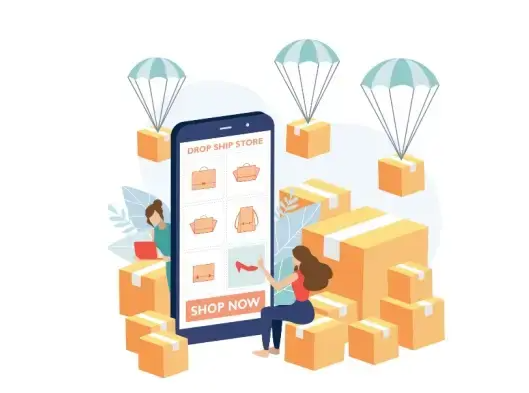Adding dropshipping to your Shopify store can be a transformative step for your e-commerce business. This model allows you to sell products without the need to hold inventory, making it an appealing option for beginners. In this guide, we will explore the essential steps to successfully integrate dropshipping into your Shopify store, covering everything from niche selection to customer relationship management.
Understanding Dropshipping
What is Dropshipping?
Dropshipping is a retail fulfillment method where the store does not keep the products it sells in stock. Instead, when a product is sold, the store purchases the item from a third party and has it shipped directly to the customer. This means you never handle the product directly, significantly reducing overhead costs.
Advantages of Dropshipping
- Low Startup Costs: You don’t need to invest heavily in inventory upfront.
- Wide Product Selection: You can offer a variety of products without worrying about storage space.
- Flexibility: You can run your business from anywhere with an internet connection.
- Scalability: As your business grows, adding more products is straightforward without requiring additional storage.
Disadvantages of Dropshipping
- Lower Profit Margins: Since you are not buying in bulk, your profit margins may be lower compared to traditional retail.
- Inventory Issues: Managing inventory can be challenging as you rely on suppliers for stock levels.
- Shipping Complexities: If you work with multiple suppliers, shipping costs and times can vary significantly.
Setting Up Your Shopify Store
Creating Your Shopify Account
- Sign Up: Visit Shopify's website and sign up for a free trial.
- Choose a Plan: After the trial period, select a plan that best suits your business needs.
- Set Up Your Store: Follow the prompts to customize your store’s appearance and settings.
Selecting a Niche
Choosing the right niche is crucial for dropshipping success. Here are some tips:
- Market Research: Utilize tools like Google Trends and social media platforms to identify trending products.
- Passion and Knowledge: Select a niche that interests you; this will help maintain motivation.
- Competition Analysis: Analyze competitors in your chosen niche to identify gaps that you can fill.

Adding Dropshipping To Shopify
Finding Reliable Suppliers
Finding trustworthy suppliers is essential for maintaining product quality and customer satisfaction. Consider these strategies:
- Supplier Directories: Use platforms like AliExpress, Oberlo, or SaleHoo to find reliable suppliers.
- Contact Suppliers: Reach out to potential suppliers to discuss their terms, shipping times, and return policies.
- Order Samples: Before committing, order samples to evaluate product quality firsthand.
Integrating Dropshipping with Shopify
Using Apps for Dropshipping
Shopify offers various apps that simplify dropshipping integration. Popular options include Oberlo for easy product import from AliExpress, Spocket for access to US/EU suppliers for faster shipping, and Printful for custom print-on-demand products.
Adding Products to Your Store
- Import Products: Use your chosen app to import products directly into your Shopify store.
- Product Descriptions: Write unique and compelling descriptions for each product to enhance SEO and attract customers.
- Pricing Strategy: Set competitive prices while ensuring profitability; consider factors like shipping costs and market trends.
Customizing Your Store Design
A professional-looking store enhances customer trust and improves sales:
- Choose a Theme: Select a responsive theme that aligns with your brand identity and appeals to your target audience.
- Customize Layouts: Adjust layouts for easy navigation and optimal user experience.
- Add Essential Pages: Include pages such as "About Us," "Contact," and "Privacy Policy" to establish credibility.
Marketing Your Dropshipping Store
Building an Online Presence
To attract customers, focus on building an online presence through various channels:
- Social Media Marketing: Use platforms like Instagram and Facebook to showcase products and engage with customers through posts and stories.
- Content Marketing: Start a blog related to your niche to drive organic traffic through SEO strategies; share valuable content that resonates with your audience.
- Email Marketing: Collect email addresses through sign-up forms on your website and send newsletters or promotions regularly.

Paid Advertising Strategies
Investing in paid advertising can yield quick results:
- Facebook Ads: Target specific demographics based on interests and behaviors; create visually appealing ads that highlight your products.
- Google Ads: Use search ads to capture intent-driven customers actively looking for products similar to yours.
Influencer Marketing
Partnering with influencers can help you reach a broader audience:
- Identify Relevant Influencers: Look for influencers in your niche who have engaged followers and align with your brand values.
- Negotiate Terms: Discuss compensation or product exchanges in return for promotions; ensure clear expectations are set.
Managing Orders and Customer Service
Order Fulfillment Process
Efficient order fulfillment is vital for customer satisfaction:
- Automate Order Processing: Use apps that automate order fulfillment processes with suppliers, reducing manual work.
- Track Shipments: Provide customers with tracking information for transparency; keep them informed throughout the shipping process.
Handling Customer Inquiries
Excellent customer service can set you apart from competitors:
- Prompt Responses: Aim to respond quickly to customer inquiries via email or chat support; prioritize addressing concerns efficiently.
- Return Policies: Clearly outline return policies on your website to manage customer expectations effectively.
Analyzing Performance Metrics
Key Performance Indicators (KPIs)
Monitoring KPIs helps you assess the success of your dropshipping business:
- Sales Conversion Rate: Measure how many visitors convert into paying customers; analyze what drives conversions.
- Customer Acquisition Cost (CAC): Calculate how much it costs to acquire each new customer; aim to reduce this over time.
- Average Order Value (AOV): Track how much customers spend on average per transaction; consider strategies like upselling or bundling products.
Tools for Analytics
Utilize analytics tools available within Shopify or third-party applications:
- Google Analytics: Track website traffic and user behavior; gain insights into how visitors interact with your store.
- Shopify Reports: Monitor sales performance and trends through built-in reporting features within Shopify.
- Klaviyo: Analyze email marketing effectiveness by tracking open rates, click-through rates, and conversion rates from campaigns.
Conclusion
Adding dropshipping to your Shopify store opens up numerous opportunities for growth without the burdens of inventory management. By following this comprehensive guide, you will be well-equipped to navigate the complexities of dropshipping successfully. Focus on building strong supplier relationships, marketing effectively, and providing exceptional customer service—these elements are key to thriving in the competitive e-commerce landscape. Embrace innovation and remain adaptable as you grow your dropshipping business!


